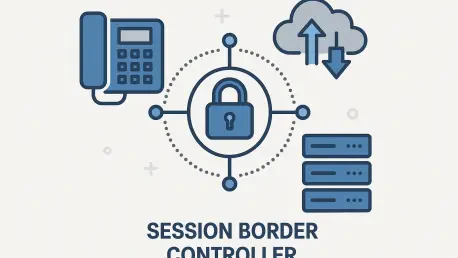The Session Border Controller (SBC) market stands as a cornerstone of the telecommunications and enterprise communication sector, delivering vital solutions that secure and optimize Voice over Internet Protocol (VoIP) and unified communication networks. These controllers function as crucial gatekeepers at the edges of IP networks, protecting voice and video interactions, ensuring quality of service (QoS), and aiding compliance with regulatory standards. As digital communication becomes increasingly central to global business operations, the SBC market is on track for substantial growth, projected to rise from USD 2.64 billion in 2025 to USD 5.0 billion by 2035, achieving a compound annual growth rate (CAGR) of 6.6%. This impressive trajectory underscores the escalating reliance on secure and efficient communication systems in a technology-driven world. The expansion reflects not only technological advancements but also evolving business needs, positioning SBCs as indispensable tools in navigating the complexities of modern connectivity.
Core Forces Fueling Market Expansion
The rapid adoption of VoIP technology serves as a fundamental driver for the SBC market, as enterprises and telecom operators transition from traditional telephony to IP-based systems for their cost efficiency and adaptability. This shift is evident across various industries, where the need to manage and secure these communications has become paramount. SBCs address this demand by providing robust session control, ensuring that voice and video data remain protected and reliable. The trend is further amplified by the growing number of businesses prioritizing digital transformation, seeking solutions that can seamlessly integrate with existing infrastructures. As companies continue to embrace VoIP to streamline operations, the reliance on SBCs to maintain network integrity and performance is expected to intensify, solidifying their role in the communication landscape through 2035.
Another critical force propelling the SBC market forward is the surge in remote work, which has dramatically increased the need for unified communication platforms. With distributed workforces becoming the norm, organizations depend on secure, seamless connectivity to maintain productivity across geographically dispersed teams. SBCs play an essential role in this context by facilitating high-quality voice and video interactions while safeguarding against potential disruptions. This demand is not merely a temporary response to global shifts but a long-term evolution in workplace dynamics, where reliable communication tools are vital for operational success. As remote and hybrid work models persist, the importance of SBCs in supporting these environments will continue to grow, driving market expansion and innovation in tailored solutions for diverse communication needs.
Security and Compliance as Market Pillars
One of the most significant catalysts for SBC market growth is the escalating threat of cybersecurity risks targeting IP-based communications, such as VoIP fraud and denial-of-service (DoS) attacks. As cyber threats become more sophisticated, the necessity for robust protection mechanisms has never been clearer, with SBCs emerging as frontline defenders of network integrity. These controllers mitigate risks by enforcing strict security protocols, ensuring that unauthorized access and malicious activities are thwarted before they can impact operations. This protective capability is particularly crucial for industries handling sensitive data, where breaches can result in substantial financial and reputational damage. The persistent evolution of cyber threats will likely keep SBCs at the forefront of security strategies, sustaining market demand over the coming decade.
Equally important is the role of regulatory compliance in driving SBC adoption, as organizations must adhere to stringent telecom and data protection laws across various jurisdictions. These mandates often require specific measures to secure communication channels and ensure privacy, tasks that SBCs are uniquely equipped to handle through features like encryption and session monitoring. Non-compliance can lead to severe penalties and operational setbacks, making the implementation of such solutions a priority for businesses and service providers alike. This regulatory landscape varies globally, with different regions imposing unique requirements, yet the universal need for compliance creates a consistent push for SBC integration. As regulations continue to tighten, the market for these controllers is expected to see sustained growth, reflecting their indispensable role in meeting legal and operational standards.
Technological Innovations and Opportunities
The rollout of 5G networks marks a transformative opportunity for the SBC market, as these advanced systems promise unprecedented speed and low-latency communication critical for modern applications. SBCs are integral to supporting and securing these networks, ensuring that the enhanced connectivity does not come at the expense of vulnerability. This is particularly relevant as industries adopt 5G to power real-time data exchanges in areas like smart manufacturing and telemedicine. Additionally, the integration of Internet of Things (IoT) devices across sectors necessitates robust session management to secure vast networks of interconnected devices. The convergence of 5G and IoT represents a frontier for SBC deployment, driving innovation and expanding market scope as connectivity demands soar through 2035.
Another noteworthy trend shaping the SBC landscape is the migration toward cloud-based solutions, which offer scalability and cost-effectiveness compared to traditional on-premises systems. This shift aligns with broader digital transformation initiatives, where agility and flexibility are paramount for businesses adapting to dynamic environments. Cloud-based SBCs enable organizations to scale operations without significant capital investment, appealing especially to small and medium enterprises (SMEs) entering the VoIP space. Moreover, the incorporation of artificial intelligence (AI) and analytics into these platforms enhances their functionality, allowing for predictive threat detection and optimized traffic management. This technological evolution not only improves performance but also positions SBCs as forward-thinking solutions, ready to meet the complex needs of future communication ecosystems.
Global Perspectives and Market Potential
North America currently dominates the SBC market, benefiting from early adoption of VoIP technologies and a well-developed telecom infrastructure that supports rapid innovation. Stringent cybersecurity regulations in the region further bolster demand, as businesses prioritize compliance alongside security. Europe follows as a strong contender, with growth fueled by unified communication initiatives and a regulatory environment that mandates robust data protection measures. Both regions demonstrate a mature market presence, yet they continue to push boundaries through investments in advanced SBC features tailored to enterprise and governmental needs. This leadership sets a benchmark for global standards, influencing adoption patterns and technological advancements worldwide as the market progresses toward 2035.
Meanwhile, the Asia Pacific region is emerging as a high-growth area for SBCs, driven by rapid enterprise network expansion and the aggressive rollout of 5G in countries like China and India. The integration of IoT applications across industries such as manufacturing and agriculture adds another layer of demand, as secure connectivity becomes critical for operational efficiency. South America and the Middle East & Africa, though growing at a more moderate pace, show promise through digital transformation efforts and increasing VoIP penetration in emerging economies. These regional disparities highlight diverse opportunities for SBC providers to customize solutions, tapping into varying levels of technological maturity and market readiness. The global landscape thus presents a mosaic of potential, with each area contributing uniquely to the market’s overall expansion.
Shaping Tomorrow’s Communication Networks
Reflecting on the trajectory of the SBC market, it’s evident that its growth has been underpinned by a blend of pressing needs and transformative technologies over the past years. The journey from a niche solution to a projected valuation of USD 5.0 billion by 2035 highlights how deeply SBCs have become embedded in securing IP-based communications against evolving cyber threats. Their role in supporting regulatory compliance also proved crucial, as businesses navigated complex legal landscapes to maintain operational legitimacy. Looking back, the steady rise in VoIP adoption and the global shift to remote work cemented SBCs as vital tools in an increasingly digital world, adapting to each new challenge with resilience.
Moving forward, stakeholders in the SBC market should focus on harnessing emerging technologies like AI and cloud computing to stay ahead of communication demands. Prioritizing interoperability across multi-vendor platforms will be key to addressing diverse system integrations, while continued investment in 5G and IoT compatibility can unlock new application areas. Additionally, tailoring solutions for SMEs offers a pathway to broaden market reach, ensuring accessibility across business scales. As the digital landscape evolves, proactive strategies to enhance security and performance will solidify SBCs as foundational elements of future communication infrastructures, guiding the industry toward sustained innovation and growth.









